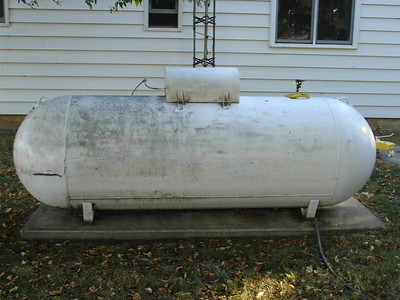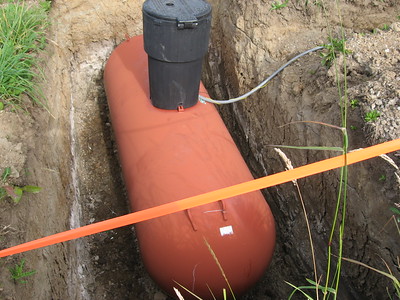
Now that you’ve decided that a 250-gallon propane tank is the right size for your home and fits your needs, you may be wondering if can you put it next to your house. We’ll answer this simple question below.
It is not recommended to put a 250-gallon propane tank next to a house. Propane tanks should be placed in an open area away from any buildings or other structures. If a propane tank must be placed next to a house, there should be at least 10 feet of clearance between the tank and the house.
Whether or not you can install a 250-gallon propane tank next to a house will depend on local zoning laws and regulations, as well as safety guidelines. In general, it is recommended that propane tanks be located at least 10 feet away from any building or property line.
It’s always best to check with your local government or propane supplier to find out the specific regulations that apply to your area, as the rules may vary depending on where you live. They may also have their specific guideline for the location of the tank that must be adhered to.
In addition to zoning and safety regulations, you’ll also want to consider accessibility and convenience when choosing a location for your propane tank. The tank should be located in an easily accessible area for delivery and maintenance and should be on a level surface.
Again, safety is the first priority, so make sure that the professional who is doing the installation is following the guidelines and regulations, to ensure the safety of yourself and your home.
Can a Propane Tank Be Up Against a House?
If you’re considering having a propane tank installed at your home, you may be wondering if it’s okay to have the tank up against the house. The answer is yes, in most cases, it’s perfectly fine to have a propane tank up against the house. However, there are a few things to keep in mind before making your final decision.
First, it’s important to check with your local code officials to see if there are any restrictions on where propane tanks can be located on your property. In some cases, there may be setback requirements that dictate how far away from the house the tank must be.
Next, you’ll need to take into account the size of the propane tank when deciding where to place it. A standard-sized tank (500 gallons or less) can typically be placed up against the house without any problems. However, if you have a larger tank (1,000 gallons or more), you may need to consider placing it further away from the house due to the weight of the tank.
Finally, you’ll want to think about ease of access when deciding where to locate your propane tank. If you have a large tank, it may be difficult to move if it’s placed up against the house. On the other hand, if you have a small tank, it will be easier to move if it’s located closer to the house.
Alternatives to Placing Propane Tanks Close to the House
| Underground Propane Tanks | |
|---|---|
| Pros |
|
| Cons |
|
| Smaller Propane Tanks | |
| Pros |
|
| Cons |
|
Can Propane Explode a House?
The short answer to this question is yes, propane can explode a house. However, there are a few things that need to happen in order for this to occur. First, there needs to be a large amount of propane present. Second, the propane needs to be ignited. Third, the ignition needs to be powerful enough to cause an explosion.
While all of these factors need to be present for an explosion to occur, it should be noted that they don’t necessarily have to happen all at once. For example, if a large amount of propane were to leak into a house over time, and then an ignition source was present, an explosion could occur.
If you think there may be a propane leak in your home, it is important to act quickly and evacuate the premises. Do not attempt to fix the problem yourself, as this could potentially create an ignition source and cause an explosion. Call your local fire department or propane supplier for assistance.
Safety Concerns You Take Note Of
When discussing safety concerns associated with propane tanks, especially large ones like a 250 gallon tank placed near a residential structure, there are several non-generic and critical issues to consider:
- Leakage Risk: Propane tanks, if they leak, can release gas at a rate dependent on the size of the leak and pressure inside the tank. Even a small puncture could release propane at a rate of several cubic feet per hour, rapidly creating a flammable atmosphere.
- Proximity to Ignition Sources: The National Fire Protection Association (NFPA) recommends a minimum distance of 10 feet from the tank to any ignition source. This distance is crucial to prevent the ignition of leaked gas, which has a flammability range of 2.1% to 9.5% in air.
- Overpressure Hazards: Pressure relief valves are designed to activate at a pressure typically around 250 psi to prevent tank rupture. In a fire, this sudden release of gas near a house could be dangerous if not properly directed away from the building.
- Impact Resistance: Tanks should withstand impact forces; however, direct vehicle impacts can generate forces exceeding several thousand pounds, potentially breaching the tank’s integrity.
- Ventilation Concerns: Adequate ventilation is essential to disperse gas leaks. Propane is heavier than air and can pool in low-lying areas if not properly ventilated. A clearance of at least 1-2 feet around the tank is generally recommended for adequate air circulation.
- Corrosion and Wear: Tanks should be inspected regularly for signs of corrosion, which can significantly weaken the tank’s metal over time. A thickness reduction of even 1/16th of an inch can compromise the tank’s structural integrity.
By adhering to these technical guidelines and measurements, the risks associated with placing large propane tanks near homes can be significantly mitigated. Regular inspections and maintenance are also critical to ensure ongoing safety.
Follow Local Laws and Fire Codes When Installing 250-gallon Propane Tank On Your Property
When you’re ready to install your 250-gallon propane tank on your property, be sure to follow all local laws and fire codes. This will help ensure the safety of your tank and keep you in compliance with your local regulations.
There are a few things to keep in mind when installing your propane tank:
- Installing a 250-gallon propane tank required concrete pad to make it stable.
- The tank should be elevated off the ground on a stable platform.
- The tank should be surrounded by an appropriate barrier (e.g., fence or wall) to prevent accidental damage or tampering.
- All connections between the tank and any other equipment must be properly sealed and tightened to prevent leaks.
- The tank should be regularly inspected for leaks, damage, or other potential problems.
To Make a Conclusion
It is not recommended to put a 250-gallon propane tank next to a house. If there is a leak, the propane could accumulate near the house and create a dangerous situation. It is better to keep the propane tank at a distance from the house.
The most important factor is the safety of the occupants of the house. If the propane tank is not properly installed and maintained, it could pose a serious fire and explosion hazard.
Another factor to consider is the amount of space available. A propane tank of this size is quite large and may not fit in some yards. Finally, the cost of installation and maintenance should be considered.
Although a 250-gallon propane tank may cost more upfront, it could save money in the long run if it is used to heat the home.

Mike is an experienced propane technician with over 15 years of professional experience in the field. He has dedicated his career to helping customers with their propane needs, from installation to maintenance and repair. Together with Jeremy, he co-founded this website to provide useful information and guidance to customers seeking reliable propane services.



